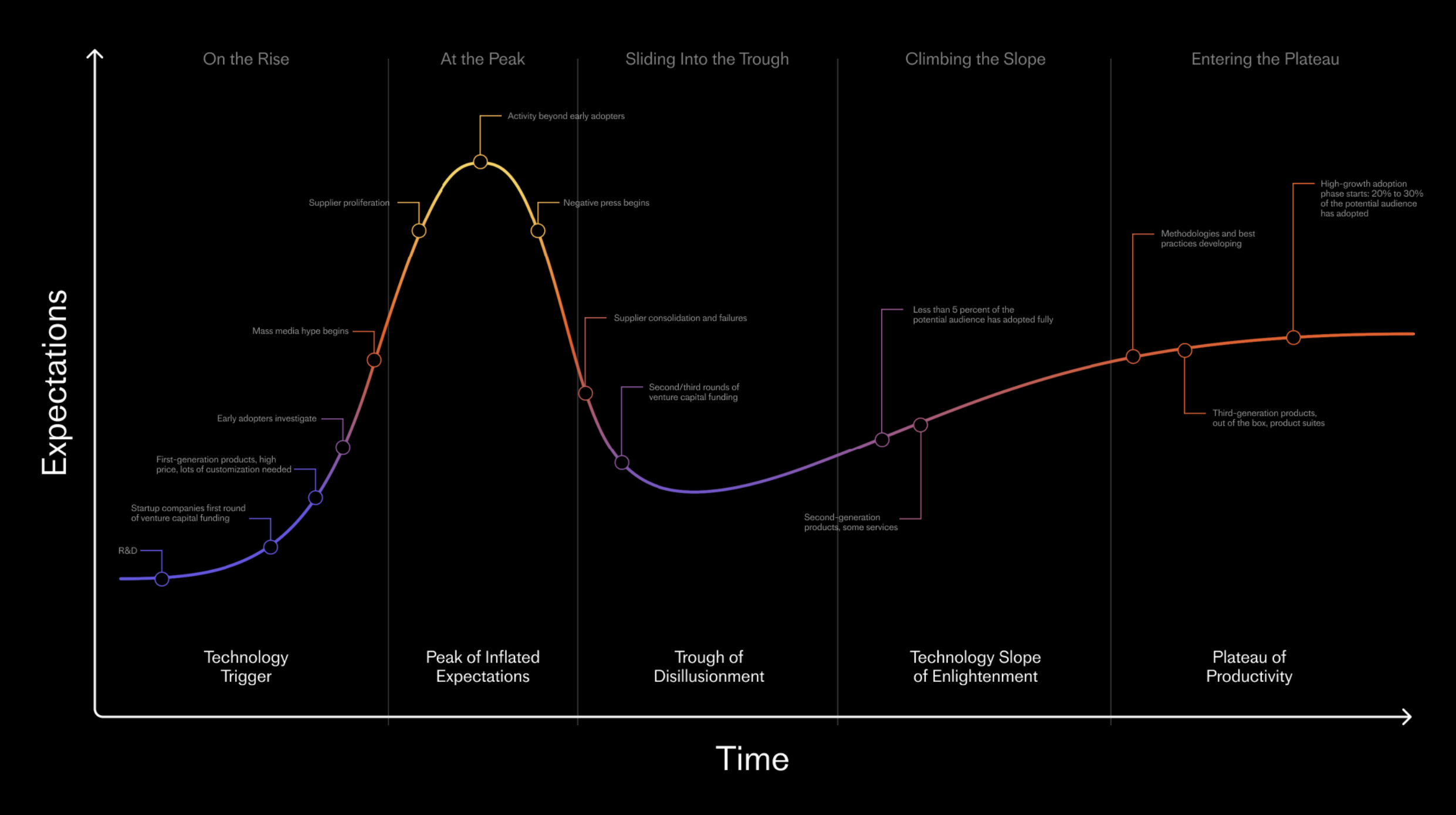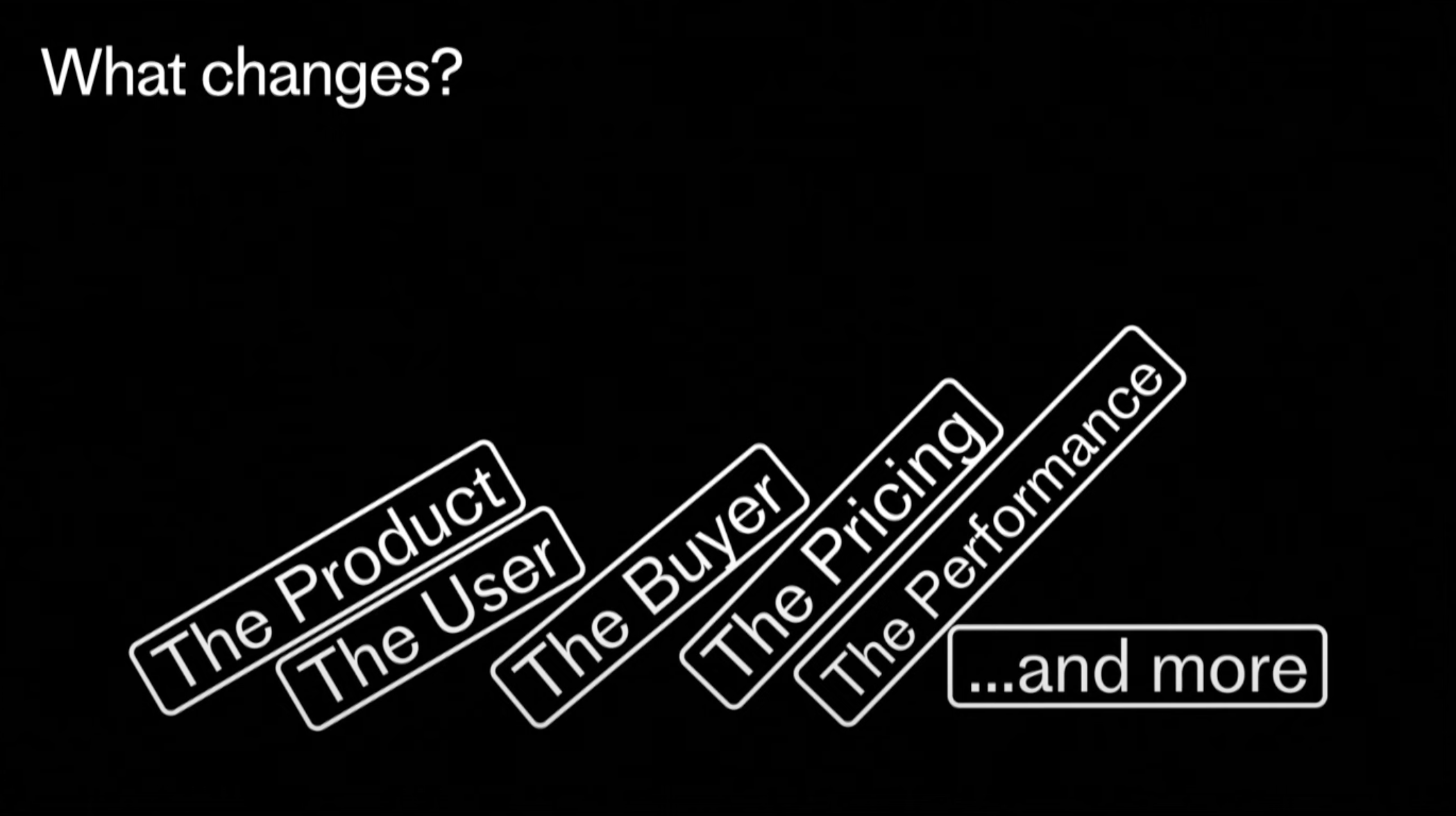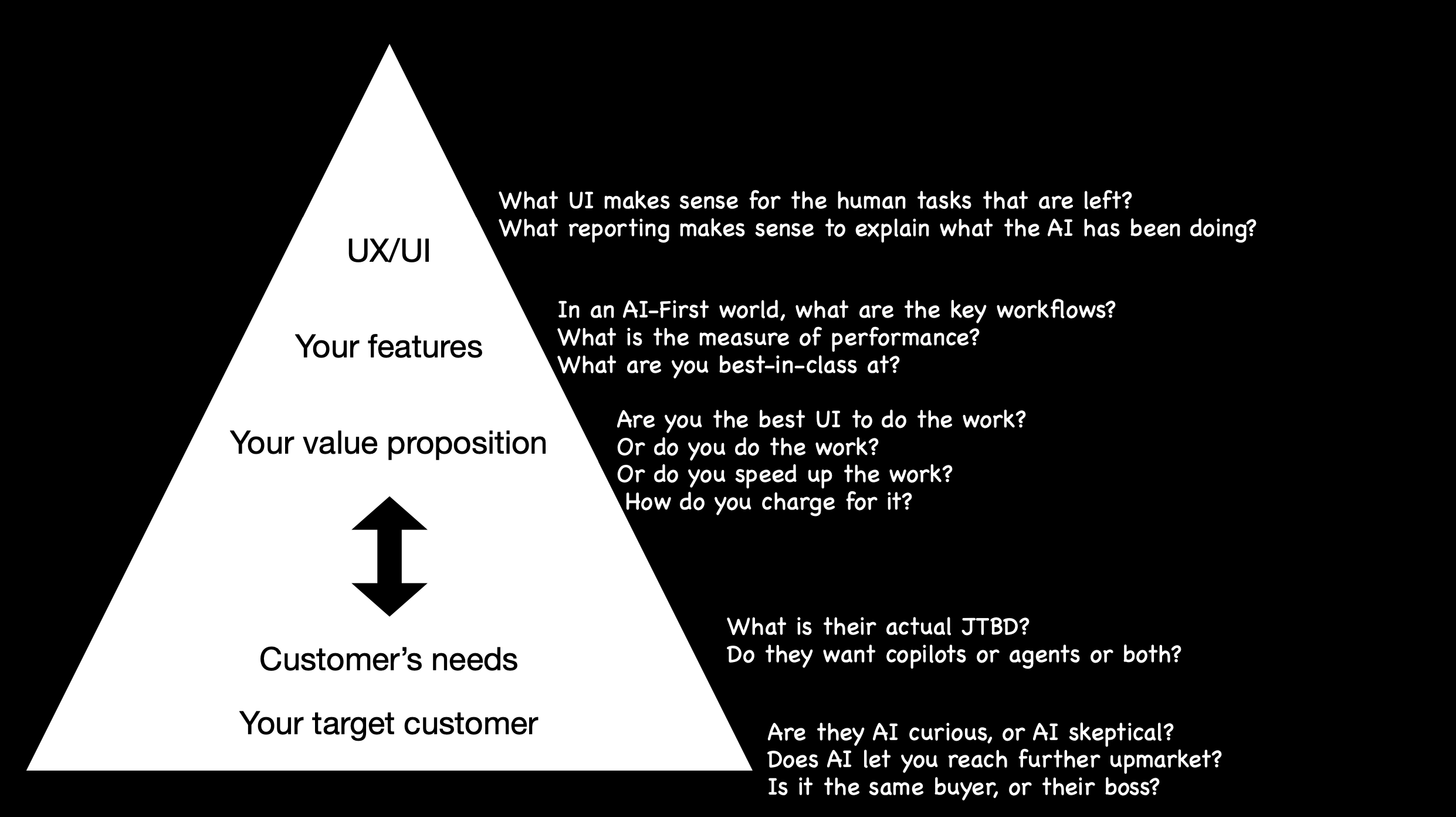Keynotes from Intercom Co-founder and CSO Des Traynor never fail to draw a crowd. At the last two Europe events, he’s taken the complex and hype-driven topic of generative AI and delivered no-nonsense sessions that make clear just how transformational this is likely to be for the SaaS industry. And, crucially, how you can keep up.
Last year, he asked how big the disruption could be. 12 months on, the disruption is here and “s**t is getting real”. In this packed session, Des covers everything from how we got here through to the future of AI native platforms, and what it means for your company. Watch the full session below or read on for key takeaways.
Tech trends and hype-cycles
To set the scene, Des reminded us that it’s still early days for AI and took us back to what else has happened over the last five years:
- Dark mode: In Des’ words “dark mode and price increases was what SaaS was about in 2019.”Everyone did it” and it was a sign that SaaS was “really running out of ideas”.
- Virtual offices: In the midst of the pandemic, things picked up for SaaS but the world of work changed. And so came the original “back to office” movement, it just existed on a tab on your browser.
- NFTs: In 2022, NFTs took off and “someone really paid $1.3M for a JPEG of a rock”.
During this time the market was on a “bull run” so there was space for things to “get weird”. Most of these trends followed a natural hype cycle, where things take off before reality hits with a thud. Then, some quiet down or even disappear, others cause more seismic shifts that go on to impact the world as we know it–the internet, mobile…AI.
Where are we in the AI hype cycle?
When Sam Altman tweeted a link to chat.openai.com in November 2022, there was an immediate sense that it was smarter than what we’d seen before.
In response, 2022 and 2023 were about creative experimentation with AI. A time in which we saw everything from fashion shows with dead celebrities to other “AI Slop” that, however impressive, wasn’t that useful.
“A lot of the stuff we did in this period was very much a solution, desperately looking for a problem to match.”
But in the midst of the experimentation there were some interesting ideas. AI code generators, tutoring and coaching solutions, and powerful design tools to name but a few.
The hype was real but where does that leave us now? According to Des, we’re probably “at the apex and about to tip over”. Here, the negativity is creeping in, with some saying there’s “too much spend and too little benefit”.
In other words, it’s getting real and over the next while, we’re going to see a lot of “death”. Be it closures, acquisitions, or mergers, the companies who added AI wrappers, developed novel solutions, or promised things that aren’t yet possible will fade away.
But it’s not all doom and gloom. While this is happening, the next generation of AI native platforms and solutions is evolving.
Software as a Service → Service as a Software
“We are moving from a world of software as a service… You sell software in the form of seats to humans who use the software to do the job. And in the future we’re going to see service as a software. This is the idea that you actually buy software that does the job.
“Like with Intercom, we sell a product called Fin. It does customer service, it just does it. It’s a different model, it’s a different way of thinking, it’s a different go-to-market, it’s a different monetisation point.”
The next generation of AI will allow us to create software that does the job for you. To survive in this market, leaders need to “rethink, redesign and re-architect all of our companies around this reality”.
With the rate that AI is improving, this presents both an opportunity (to build the next generation of your product) and a challenge (building against a moving target, with tech that’s changing all the time).
As a result, people are building on a spectrum, illustrated by the example below:
- Tools that do some of the work for you: For example, helping an SDR write personalised emails.
- Tools that heavily augment your workflow: A sales tool that goes beyond emails to automate the sending process.
- Tools that do the job: An AI SDR that can find your prospects, get their email addresses, engage with them, and even demo.
Deciding which to build, use or invest in isn’t an easy decision:
“This to some degree is the biggest question SaaS companies that are pivoting to AI face. What is the right shape of solution that we can definitely build that, that the market definitely wants, that is within those two constraints, as ambitious as possible.”
To help make the decision, you need to look at your workflows and ask:
- What needs human verification,
- What can be heavily augmented
- And what can be done completely by AI.
What changes in a world of AI native platforms?
What changes as we make this pivot to AI native platforms? Well, everything.
“The reality is it all changes. Every single assumption you might have made about your business is now up for grabs.”
- User: If frontline staff changes, principal or more senior people may become your users.
- Buyer: The economic buyer might be the CFO but if it’s a strategic move (e.g. that impacts frontline workers), you might need to go a level higher to the CEO.
- Pricing: How you monetise has to change. Intercom’s AI, Fin, is charged per resolution, rather than by seats or conversations.
- Performance: People judge you differently. Des mentioned that at Intercom people don’t ask how good their UI is anymore. Instead it’s “how good is your AI?”
It’s a significant transformation, one that Des’ says could be as big as electricity.
He explained how things like the 9-5 working day and late night shopping are by products of electricity:
“All of these things that we now take for granted are all downstream of the decision to adopt electricity. I think we’re going to see [something] similar with AI… We’re going to see people dabbling, regulating, experimenting, and then we’ll start adopting. And then years later we’ll see all sorts of downstream societal changes. All in the case of electricity for sure, and hopefully in the case of AI, mostly for the better, but it just takes a while. So…if by 2026 everything I’m saying hasn’t happened. Give it a second.”
Transformative AI use cases
Despite being relatively early on in the AI lifecycle, we’re seeing big shifts already in certain industries, including:
- Software engineering: Tools like Create XYZ that can turn an idea into an app in 15-20 seconds. And other tools like Figma and Github Co-pilot that are changing software engineering as we know it.
- Law: Tools likeHarvey that streamlines lengthy tasks for legal teams, taking processes that take months down to minutes.
- Health and medicine: Tools like Aidoc that can analyse hospital scans and give doctors and medical teams a list, in order of priority.
- Customer service: AI tools like Intercom’s Fin are already able to handle large quantities of support volume (Fin averages 51%). Building on this, support solutions will go beyond chat to full service frontline tools.
Building AI-first software
“The way we think about AI first is we say it’s a generation of software that’s built that assumes LLMs were always there. It involves taking the existing product, deconstructing it and working out what it would look like if it was built in the era of AI and building an entire business around that.”
There are different approaches to implementing AI-first thinking. The default is to stick “generate”, “build”, “create”, and “imagine” buttons on an existing dashboard and hope it’s enough.
It will not be enough.
Instead, go back and look at product-market fit from an AI perspective, and ask:
- Who are you selling to?
- What is the actual thing they need done?
- What level of it can you do with AI? Are you doing the work for them or is it a co-pilot?
- What does the feature set need to look like for that to happen?
Ultimately, AI-first thinking has to be “built-in, not bolted on” because it fundamentally changes how we build and deliver products. Admitting he doesn’t have all the answers, Des identified the questions you need to be asking for true AI-first thinking and product development.
- How do you build product? You have a new set of capabilities to build. Once shipped, you have to go back and measure how well it does the thing you say it does.
- What product do you sell? How ambitious can you be while making sure the market is ready to buy it?
- Who is the buyer? Buyers are varied. For example, a CTO could buy a coding co-pilot but some decisions will need to be made by the CEO.
- How do you charge? There will be different pricing models in the era of AI. How will you communicate this to customers? And how will you measure it?
- What brand do you need for it? Traditional enterprise SaaS brands won’t work in the AI world. You need an AI native brand.
- What sales motion should you use? Do you need more awareness or are your customers skeptical about the capabilities of the software? Many factors will influence how you take an AI product to market.
Learn more about what AI means for SaaS
“In times of change the learners will inherit the earth, while those who think they’re learned will find themselves perfectly prepared for a world that no longer exists.”
Closing his talk, Des encouraged the audience to “be learners” and lean in to the change, despite it feeling uncomfortable. He warned leaders to avoid baby steps and to take the big swings. It’s a time to ask the hard questions and make the decisions that need to be made.
In the spirit of learning, we’ve spoken to some of the most influential people in SaaS to get their take on the generative AI wave and its implications for the software market. Check out the conversations below:
- Accel Euroscape 2024: AI eating Software
- Tomasz Tungus (Theory Ventures) on how AI is changing the future of SaaS
- How to measure and increase AI productivity gains (with GitLab CSO and CMO Ashley Kramer)
- From AI skeptic to advocate, how it informed Tines’ product roadmap (with CEO and Founder Eoin Hinchy)













